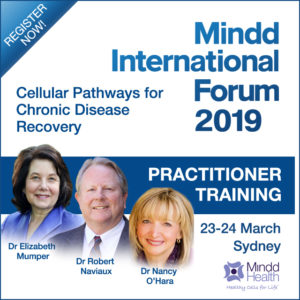Getting to know the body’s own natural system to restore health
Complex disorders like autism can be improved — but cannot necessarily be resolved by measuring and treating each of the molecular problems and correcting them one-by-one. The healing cycle is the body’s own natural system to restore health, and it can either be supported – or blocked.
Learn about the human body’s innate healing function and the Cell Danger Response
Complex disorders heal by triggering an ancient program of molecular changes that “reboots and restores” normal cell and body-systems communication, such as the function of the mitochondria. This program is called the healing cycle.
The Healing Cycle and The Cell Danger Response: Interview with Dr O’Hara
We have been able to utilize cutting edge ways to help children and family members to reach their fullest potential and be their healthiest. At the Mindd Forum Public Education 2019 we use different types of techniques and learning tools to help you understand how to help your family members to get better.
I’ve been dealing with families who are dealing with chronic illness for decades and I know all of us as mothers, physicians, fathers and grandparents are looking for ways to help those in our families who are sick with a chronic illness. Whether that be asthma, diabetes, chronic fatigue syndrome, cancer, autism or ADHD. We just want to help those in our families to get better.
What is the Cell Danger Response?
One of the ways we have discovered we can do this is by understanding the Cell Danger Response. It’s something that all of us have within our cells every single moment of every single day. It is how we function and how each of us handles stressors, viruses, chemicals, toxins, and anything that comes into our system that we need to get rid of.
Let’s just say I get exposed to a virus. My body and mitochondria within the cells react to that virus-like an army reacts to the enemy. The virus is fought, it goes away and the army retreats. The cell danger response is the army; then it retreats, and we go back to homeostasis. The same thing happens with a chemical. The chemical is no longer there after we send out our cell danger response and we go back to our normal state of homeostasis.
The Cell Danger Response and Chronic Disease
Those of us who deal with a chronic illness such as autism, other neurodevelopmental problems or any type of chronic illness is experiencing a dysfunctional and persistent cell danger response as the core problem.
When there is chronic illness the cell danger response persists. Let’s use autism as an example as it’s a condition I am very familiar with. Let’s say a virus comes in and the cell danger response reacts. The army sentries go out and our mitochondria release an inflammatory response to fight the virus in these children or adults with chronic illness. This results in the cell danger response persisting and constantly being in that fight or flight mode, trying to fight a virus that isn’t there. This causes a heightened level of inflammation and adrenal stress with an inability to turn off. When this happens, our system is in a state of disarray and dysregulation.
The good news is, based on recent research and clinical experience, there are now multiple strategies to support the healing cycle and to manage the cell danger response – which lead to better health outcomes.
Learning Objectives for Dr O’Hara’s presentation:
- Discover new ways to protect the health of your mitochondria
- Know what protecting mitochondria means for your health outcomes
- Learn about the healing cycle and how this impacts you and your family’s health
- Ask questions related to cellular energy, common conditions and overall health

More specific information on the healing cycle and its role in common and chronic health conditions will be presented at the Mindd Forum. You can see the schedule of the 2019 Mindd Forum here…
To read more about the Cell Danger response see ‘A New Approach to Chronic Illness: Understanding the Cell Danger Response’







